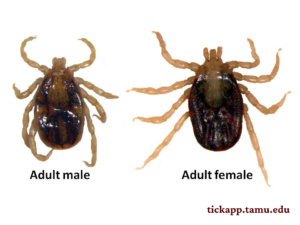
Species: Dermacentor (Anocentor) nitens (Neumann)
Description: Larvae 0.5 mm long x 0.4 mm wide; nymphs 1.12 x 0.8 mm (L x W). Dimensions among male ticks average 2.37 mm (L) by 1.44 mm (W). Males are inornate and appear yellowish-brown in color. Females range 2-3.1 mm long and 1.7-2.0 mm wide. The scutum of female ticks is brownish yellow in color, somewhat longer than wide, has no discernable pattern, but appears quite glossy upon inspection.

Distribution: The range of the tropical horse tick in the US is limited to southern regions of Texas and Florida. This tick is also found throughout subtropical regions of Mexico, Central America, South America, the Caribbean, and Galapagos Islands.
Hosts: The primary hosts are equids; horses, mules and asses. Collection records from sheep and goats exist from south of the US border. Feeding on other ruminants including deer and cattle has been observed. Excessive feeding may cause edema, hair loss, and scarification of host ears, contributing to skin and handling sensitivity.
Biology: The tropical horse tick exhibits a one-host tick life cycle and generally prefers feeding on the exterior parts of its hosts ears, requiring about 26 days to complete feeding. In large infestations, these ticks may also be found on other parts of the head, mane, genital, and anal regions.
Associated Disease Pathogens: This tick is the principal vector responsible for causing equine piroplasmosis, a blood-borne disease of horses spread by the haemoprotozoan parasites Theileria equi and Babesia caballi.
Similar Tick Species: The winter tick (Dermacentor albipictus) is similar in appearance, and is also a one-host tick found on horses and similar hosts in North and Central America.
